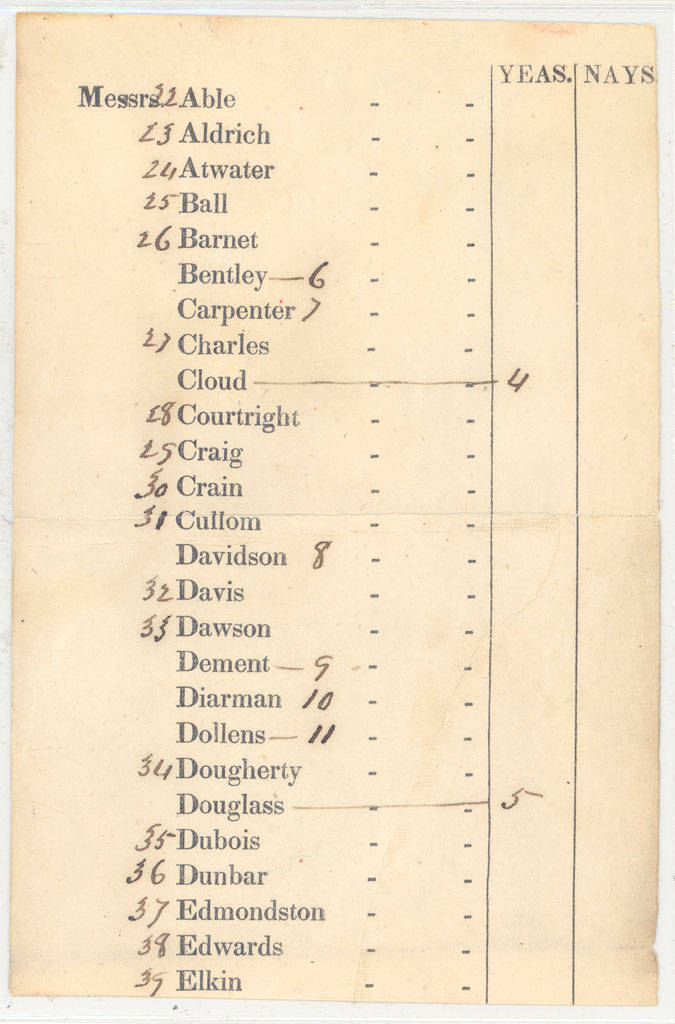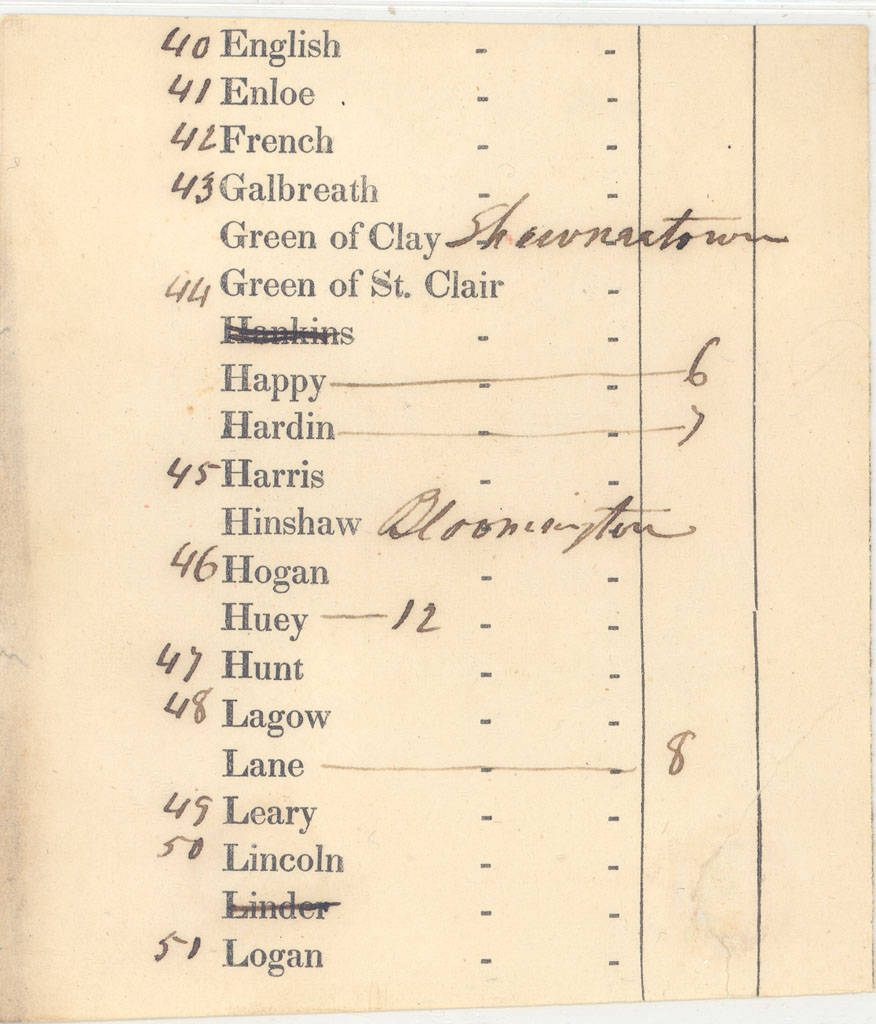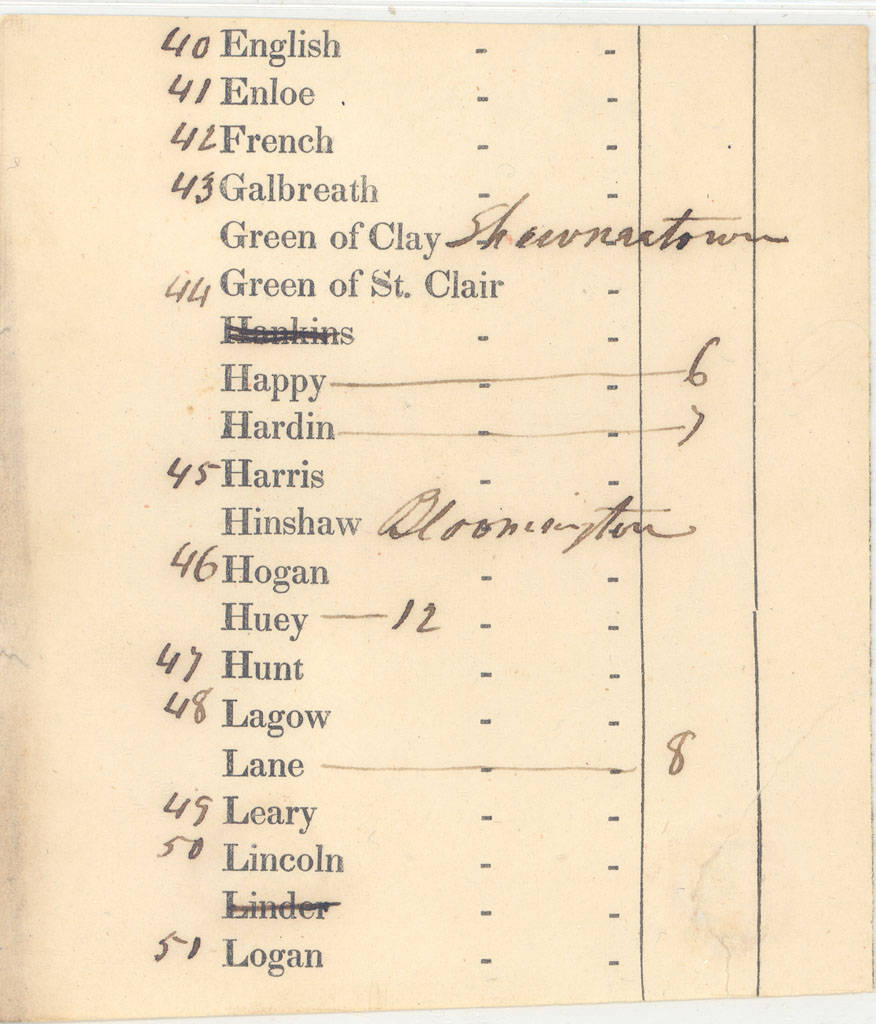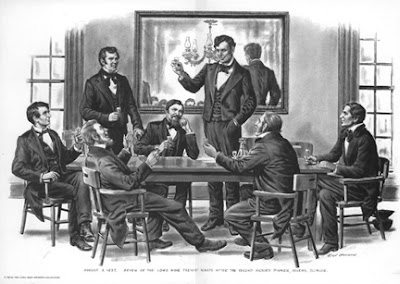Moving to Springfield

Barely a year after statehood, Illinois’ new state government abandoned its original riverfront capital city of Kaskaskia and moved northeast to higher ground in Vandalia. It proved to be a wise choice: within a few decades, the Mississippi had changed course, and much of the original seat of government lay at the bottom of the river.
Less than 20 years later, Illinois was once again looking for a new capital city. The efforts of a freshman state legislator and eight of his colleagues would help shift it farther north.
It was never entirely clear whether Vandalia was intended to be a temporary or a permanent capital when state government moved in during 1820. The years in Illinois’ second capital city had been difficult. The first statehouse in the Fayette County town had burned to the ground in 1823. Another had been built, but it was already showing signs of deterioration: floors sagged, walls bowed and a local congregation which held its prayer meetings in the building decided it was prudent to find a better location.
Meanwhile, the Act which had moved the seat of state government to Vandalia was about to expire: it had a sunset date of 20 years, which was coming up in 1839. In anticipation of the recurrence of the issue, legislators began making the case for their preferred city. They agreed to place on the August 1834 general election ballot a question about the future location of the capital.
“There shall be opened at each place of voting a book, in which shall be entered the votes of the qualified voters in favor of the following named places, as their choice for the permanent location of the seat of government of this State, after the time prescribed by the Constitution for its remaining at Vandalia,” read the act of the 8th General Assembly which authorized the referendum. It then listed the options and the stakes: “Geographical center of the State, Jacksonville, Springfield, Vandalia, Alton and Peoria. The place receiving the highest number of votes shall forever thereafter remain the seat of government of the State of Illinois.”
The referendum’s results were disappointing. In a low-turnout election, the riverfront city of Alton emerged as the front-runner, but with only about a third of the vote. Vandalia and then Springfield were close behind. It was far from a consensus, and state leaders decided to disregard the vote. Alton would go on to achieve importance as the home of abolitionist publisher Elijah Lovejoy and the site of a famous Senate debate a quarter century later, but it never again came as close to becoming the state capital.
So the debate would go on. Legislators from different parts of the state argued fiercely for several different cities. Among their number was a tall representative from rural Sangamon County named Abraham Lincoln, who attended sessions of the House in his one and only suit, which he had purchased with borrowed money. Lincoln advocated for his county’s seat, Springfield.
In 1835, as plaster came crashing down onto the floors of the state’s third capital building, Governor Joseph Duncan signed an appropriation for $5000 to build a new capital building in Vandalia. Local residents kicked in some money on their own, and soon a stately new capitol building was being constructed along the route of the National Road in the center of town. It was completed for a total cost of $16,000, and unlike its three predecessors it has stood the test of time: the building still stands today.
The new capitol opened in 1836, but even this much-improved structure did not settle the issue. Lincoln, particularly, redoubled his efforts, along with eight of his Whig colleagues from Sangamon County. Together, these nine legislators; all standing more than six feet tall; came to be known as the “Long Nine,” and their persistence would make Illinois history.
In the next session of the legislature, Lincoln filed a bill to relocate the capital to Springfield. He was supported in this effort by his Long Nine colleagues, but not supported by freshman Rep. Stephen Douglas, who argued for his home town of Jacksonville. Douglas, however, was more interested in the other great issue of the 10th General Assembly: the question of an internal improvements bill.
Douglas’ plan called for three major infrastructure projects: a canal linking the Illinois River with Lake Michigan, a north-to-south railroad (which would become the Illinois Central), and an east-to-west railroad across the center of the state, to be called the Northern Cross. Lincoln; who had emerged as the leader of the Long Nine, and who had campaigned on the issue of internal improvements; offered his support for the program, if it could be expanded to include canals and other infrastructure improvements for villages and rural areas like the one he represented. Douglas agreed, and soon Lincoln was rounding up Whig backing for the program. But he was also working to build support for Springfield as the new capital.
As the internal improvements bill ballooned in size and cost (the state would eventually issue $10 million in bonds and the Illinois and Michigan Canal would issue more of its own bonds as well) it attained the votes needed for passage. Douglas was uneasy, writing to a friend that he had, “never for a moment dreamt of such a wild and extravagant scheme,” but in the end he was pleased to have achieved his goal and passed the legislation.
Having enacted the internal improvements plan, legislators now moved back to the question of where to locate the capital. Their deliberations were sometimes interrupted by carpenters still working on the inside of the new capitol building in Vandalia, and by the hacking coughs of their colleagues who were having bad reactions to the still-wet plaster in the chamber. With each cough, support for keeping the capital in Vandalia was dwindling, while support for Lincoln’s idea to relocate to Springfield was growing.
The vote on the next capital city was held not long after the passage of the internal improvements bill, on February 25, 1837. Springfield put forth a proposal to build the new capitol building on the town square, and to donate $50,000 to the effort. At a joint session of the legislature held three days later for the express purpose of settling the capital city question, legislators from the northern reaches of the state joined with the Long Nine, and on the fourth attempt at a vote, Lincoln’s legislation passed. The capital was on its way to Springfield. In all, Springfield received 73 votes, Vandalia 16, Jacksonville 11, with nine other cities receiving at least one vote.
The question of how much wheeling-and-dealing was genuinely involved in the vote on the location of the capital has long been disputed, with an Illinoisan of no less stature than former U.S. Senator Paul Simon writing in a Lincoln biography that it was not a major factor. But whatever went into the final decision, in 1839, Springfield became the capital city of Illinois.
A new capitol building, one of the most impressive state houses in the west, was soon under construction. The cornerstone was laid on July 4, 1837, for the Greek Renaissance structure; compete with a dome and porticos; which was to be built on the block in downtown Springfield bounded by Adams and Washington Streets between 5th and 6th. The speaker at the occasion was Edward Baker, a close friend of Lincoln who would go on to serve in the U.S. Senate. The two story structure was designed by architect J.F. Rague of Springfield’s Mechanics Institute.
It was not completed until 1853, and cost $260,000, which was twice what was expected. The building would remain the seat of state government until 1876, when it moved once again to its current home a few blocks away at 2nd and Monroe Streets.
Lincoln’s triumph marked a high point in a life filled with ups and downs. But storm clouds were gathering on his horizon. Lincoln was nominated for Speaker of the House, but fell short by five votes. A nationwide economic crisis, the Panic of 1837, struck just months after passage of the internal improvement bill. Some observers began to raise doubts about the amount of debt Illinois had incurred for the plan, but Lincoln was still buoyed by its successful passage, winning re-election in 1838. He moved from New Salem to Springfield, eventually opening a law office across the street from the new capitol building.
But then a second economic crisis hit in 1839, hammering the Midwest and driving down the value of railroad and canal bonds. The ambitious internal improvements program collapsed under its own weight, though a few of the canal and rail projects were built. Douglas by this time had moved on: he was picked to head the federal government’s Springfield land office, and then was appointed Illinois Secretary of State. Lincoln was left behind in the legislature to deal with the consequences. The state sank into a debt which it would not be able to fully repay in Lincoln’s lifetime. Lincoln squeaked to re-election in 1840, but in 1842, perhaps seeing the writing on the wall, he did not seek re-nomination. He would remain an advocate of internal improvements during his term in Congress, but without much success.

Lincoln seemed to have hit rock bottom. But the vision he had for his adopted hometown began to become a reality, as the city grew and prospered with the arrival of state government. And as it did so, Lincoln’s fortunes would rise and fall, and rise again. Two decades after the legislature moved into the state’s new capitol building in downtown Springfield, Lincoln would visit the building to deliver his most famous speech up to that time, in which he would declare that, “a house divided against itself cannot stand.”
The speech, and the Senate campaign of which it was a crucial part, propelled him to national fame. Two years after that, he would return to the same building and borrow office space from Governor John Wood. There he prepared for the momentous task of taking office as the newly-elected 16th President of the United States.
ROLL CALL




